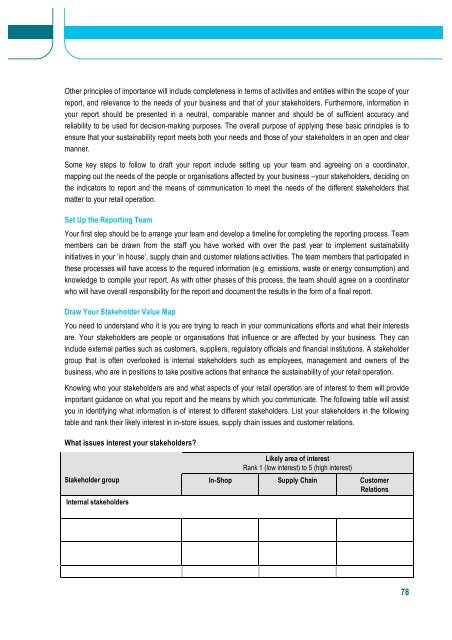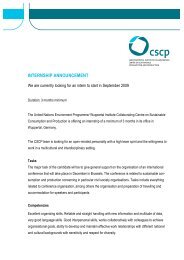Retailers Calendar
Retailers Calendar
Retailers Calendar
You also want an ePaper? Increase the reach of your titles
YUMPU automatically turns print PDFs into web optimized ePapers that Google loves.
Other principles of importance will include completeness in terms of activities and entities within the scope of your<br />
report, and relevance to the needs of your business and that of your stakeholders. Furthermore, information in<br />
your report should be presented in a neutral, comparable manner and should be of sufficient accuracy and<br />
reliability to be used for decision-making purposes. The overall purpose of applying these basic principles is to<br />
ensure that your sustainability report meets both your needs and those of your stakeholders in an open and clear<br />
manner.<br />
Some key steps to follow to draft your report include setting up your team and agreeing on a coordinator,<br />
mapping out the needs of the people or organisations affected by your business –your stakeholders, deciding on<br />
the indicators to report and the means of communication to meet the needs of the different stakeholders that<br />
matter to your retail operation.<br />
Set Up the Reporting Team<br />
Your first step should be to arrange your team and develop a timeline for completing the reporting process. Team<br />
members can be drawn from the staff you have worked with over the past year to implement sustainability<br />
initiatives in your ‘in house’, supply chain and customer relations activities. The team members that participated in<br />
these processes will have access to the required information (e.g. emissions, waste or energy consumption) and<br />
knowledge to compile your report. As with other phases of this process, the team should agree on a coordinator<br />
who will have overall responsibility for the report and document the results in the form of a final report.<br />
Draw Your Stakeholder Value Map<br />
You need to understand who it is you are trying to reach in your communications efforts and what their interests<br />
are. Your stakeholders are people or organisations that influence or are affected by your business. They can<br />
include external parties such as customers, suppliers, regulatory officials and financial institutions. A stakeholder<br />
group that is often overlooked is internal stakeholders such as employees, management and owners of the<br />
business, who are in positions to take positive actions that enhance the sustainability of your retail operation.<br />
Knowing who your stakeholders are and what aspects of your retail operation are of interest to them will provide<br />
important guidance on what you report and the means by which you communicate. The following table will assist<br />
you in identifying what information is of interest to different stakeholders. List your stakeholders in the following<br />
table and rank their likely interest in in-store issues, supply chain issues and customer relations.<br />
What issues interest your stakeholders?<br />
Likely area of interest<br />
Rank 1 (low interest) to 5 (high interest)<br />
Stakeholder group In-Shop Supply Chain Customer<br />
Relations<br />
Internal stakeholders<br />
78
















